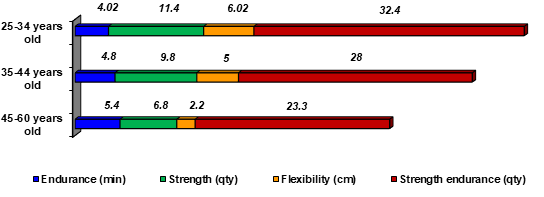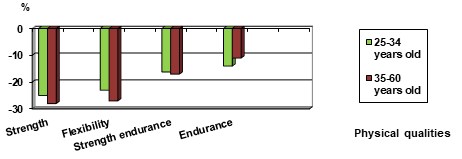MOJ
eISSN: 2574-9935


Review Article Volume 6 Issue 2
State University of Physical Education and Sports, Moldova
Correspondence: Aftimichuk Olga, State University of Physical Education and Sports, Moldova
Received: July 05, 2023 | Published: July 17, 2023
Citation: Olga A. Age dynamics of physical preparedness of adult population. MOJ Sports Med. 2023;6(2):79-81. DOI: 10.15406/mojsm.2023.06.00144
The article presents the age dynamics of physical fitness of men and women of working age. The importance of physical exercise for health promotion has been proven.
Keywords: age dynamics, physical preparedness, adult population
The data of modern scientific research indicate that the health of the nation is not directly dependent on the amount of spending on health care. According to experts, the state of health of the population in a particular country depends on 15-20% of genetic factors, 50-55% on social conditions and lifestyle, 20-25% on the degree of environmental pollution, i.e. habitat, by 10-15% of the state and level of healthcare in the country.1 As can be seen, to a greater extent, the level of health is determined by social conditions and a healthy lifestyle. The experience of the richest foreign countries shows that the growing costs of medicine do not always provide an effect. Therefore, money is invested there in sports and recreation programs aimed at creating a healthy lifestyle for the population.2
Physical preparedness reflects the level of development of a person's physical abilities and depends on a lot of factors, such as gender, age, health status, morphological features of the body structure, willpower, ability to mobilize, mental state and a number of other influences. The level of development of physical qualities reflects the state of human health, since the manifestation of certain abilities requires the mobilization of certain body functions.3 However, the insufficient motor activity of the modern person, due to technical progress, is accompanied by a decrease in the functional capabilities of the body. The neuro-reflex connections laid down by nature and fixed in the process of hard physical labour are disrupted, which leads to a breakdown in the regulation of the activity of the cardiovascular and other systems, metabolic disorders and the development of degenerative diseases.
The purpose of our study was to determine the level of physical preparedness of the adult population of the Republic of Moldova. The objectives of the study included the analysis of the age dynamics of physical preparedness.
As part of the dissertation research, testing of the physical preparedness of men in the age range of 25-60 years and women of 25-55 years was carried out. The age was not chosen by chance: this age period is marked by the greatest working capacity. The establishment of the age period of the able-bodied population proceeded from the position that, basically, until the age of 25, a person is determined in the profession (we are talking about training in educational institutions; university education usually ends at 23-24 years old). When the study was conducted, in our country, men retired at 62, and women at 57. For the study, we further narrowed the age period of the subjects' ability to work by 4-5 years, taking into account unpredictable deviations, both in determining employment and health status.
The experiment involved men and women of 3 age groups: group I – 25-34 years old, group II – 35-44 years old and group III – 45-55/60 years old. The physical preparedness of the subjects was determined by international tests used in various countries.4–8 For men, the following tests were selected: 1000m Run Test_Endurance; Pull-up Test_Strenght; Stand and Reach Flexibility Test; Body Flexion-Extension Test_Strenght endurance. For women, we have selected the following tests: Stand and Reach Flexibility Test; Bench Push-ups from the knees test_ Strenght endurance; Low Bar Pull-ups in 30 seconds Test_Speed-strenght endurance; Romberg Test_Static balance.
According to research results, the decrease in the level of development of physical qualities of men in the range of 25-60 years occurs gradually and evenly, without pronounced periods of involution and stabilization (Figure 1). The results of the studies are statistically significant at the level of ρ < 0.05.

Figure 1 The dynamics of the decrease in the level of development of physical qualities of 25-60 years old men.
It has been established that the greatest decline in strength is observed in those who do not engage in physical culture at the age of 40 to 50 years, and in those who train regularly from 50 to 60 years. Strength is decreasing at the highest rate (by 53%). Moreover, significant regression is observed in the age of 40-60 years (Figure 2).

Figure 2 The intensity of the decline in the physical qualities of men aged between 25-60 years old (%).
The degree of flexibility reduction was 50% with the highest rate of regression in the second half of the age range of 25-60 years. Strength endurance gradually and evenly decreases. The intensity of its decline it can be observed in the age range of 25-34 years and is 16.2%. In the second half of the studied age period (35-60 years), the intensity of the decrease in strength endurance represents 17%. In general, the dynamics of involution of the mentioned quality is characterized by an insignificant rate of decline compared to other physical qualities and amounts to 33.2%. The aerobic capabilities of the subjects are characterized by the smallest regression of all the above physical qualities over the thirty-five-year period. A more significant rate of decline it can be observed in the first half of the studied age period and is 14%, and in the second already 11%. In this way, the involutional processes in different organs and systems pass differently. Those structures and functions that are closely connected with the existence of the main life process are preserved in ontogenesis longer. In accordance with the data obtained, the highest rates of decline over the thirty-five-year period of ontogenesis of men (25-55 years) are characterized by muscle strength (53%) and flexibility (50%). The least regression is experienced by strength endurance (33.2%) and aerobic endurance (25%). Another situation can be observed in the study of the level of physical fitness of women, for which we chose tests that turned out to be the most informative when testing the subjects of mature age.9
Evaluation of the results of testing women of group I, which was carried out in accordance with the rating scale for women of this age,9 revealed that the indicators of flexibility and speed-strength endurance correspond to a low level. However the indicators of strength endurance and static balance revealed an average level of development of this quality (Figure 3).

Figure 3 Dynamics of the level of decrease in the development of motor qualities of women aged 25-55.
In this way, the results of studies of the physical fitness of women of mature age indicate that the level of development of basic physical qualities is significantly reduced even at a young age, which is associated with a rather low physical activity. Due to the lack of an evaluation scale for indicators of physical fitness of women of the second mature age (35-55 years), the average data on the performance of motor tests of women in the groups II and III were compared with the results of women in group I. At the same time, their significant decrease (ρ < 0.05) has been observed during all tests (Figure 4).
The results of women aged 35-44 compared with similar results of women aged 25-34 in the flexibility test decreased by 13.9%, while in the age category 45-55 years – almost two times, 35.2%. In the strength endurance test, group II of women reduced their performance compared to group I by 33.7; III-rd – by 57.5%. Accordingly, speed-strength endurance decreased by 36.9% and 69.6%; and static equilibrium – by 32.9% and 46.5%. As you can see, the most rapid regression in women occurs in terms of strength indicators; the quality of flexibility lasts the longest, then the static balance. Summarizing the above stated, we can observe that the changes that occur in the body of women with age, in the absence of additional physical activity, lead to a significant decrease in physical preparedness, which, of course, affects their health and but also the working capacity.
Starting from the age of 30-40, in women, the indicators of relative strength decrease, the muscular apparatus slowly regresses, and already at the age of 45-55, higher rates of aging of motor functions occur. The decrease in power capabilities is due to a decrease in the volume of muscle mass,10 and this indicates that physical culture and health programs for women of mature age, along with other means, should widely use means of strength and speed-strength nature.
In general, it can be stated that the decrease in the physical preparedness of a modern people, both men and women, depends not only on the processes of involution. Often this is connected to their lack of physical activity. Moreover, in women, this is observed both at a young and also at an older age, and is considered by us as a factor that significantly limits the level of physical performance, worsens the level of health, and therefore reduces the quality of life.
None.
The author declares that there are no conflicts of interest.

©2023 Olga. This is an open access article distributed under the terms of the, which permits unrestricted use, distribution, and build upon your work non-commercially.